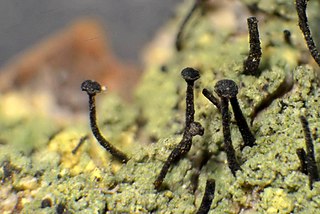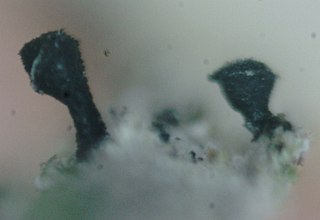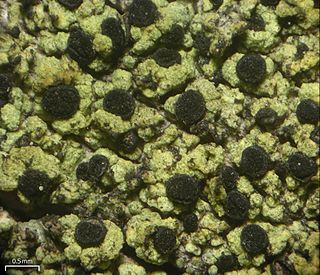
Calicium is a genus of leprose lichens. It is in the family Caliciaceae, and has 40 species.

The Caliciaceae are a family of mostly lichen-forming fungi belonging to the class Lecanoromycetes in the division Ascomycota. Although the family has had its classification changed several times throughout its taxonomic history, the use of modern molecular phylogenetic methods have helped to establish its current placement in the order Caliciales. Caliciaceae contains 39 genera and about 670 species. The largest genus is Buellia, with around 300 species; there are more than a dozen genera that contain only a single species.
Calicium sequoiae is a crustose lichen that has only been found growing on old-growth redwood trees in California. It is a species of pin lichen in the family Caliciaceae. Apothecia are white-powder coated (pruinose). The unusual spores have spiral ridges.
Acerentomon quercinum is a species of proturan in the family Acerentomidae. It is found in Europe and Northern Asia.

Calicium abietinum, commonly known as fir pin or black stubble, is a crustose lichen that is found growing on trees throughout much of the world.
Calicium chlorosporum is a crustose lichen that is found growing on trees throughout much of the world.

Calicium glaucellum is a crustose lichen that is found growing on trees throughout much of the world. The species is similar to Calicium abietinum.
Calicium robustellum is a crustose lichen that is found growing on trees in the Gascoyne region of Western Australia and in Queensland.

Calicium salicinum is a crustose lichen that is found growing on trees in the South West region of Western Australia.
Calicium tricolor is a crustose lichen that is found growing on trees in the South West region of Western Australia.
Calicium victorianum is a crustose lichen that is found growing on trees and wooden materials.
Chaenothecopsis vainioana is a species of lichenicolous fungus in the family Caliciaceae that is found in Europe. It was first formally described by Czech lichenologist Josef Nádvorník in 1940 as a member of the genus Calicium. The specific epithet honours Finnish lichenologist Edvard August Vainio. Leif Tibell transferred it to genus Chaenothecopsis in 1979. Calicium vainioanum has been reported growing on Arthonia, Lecanactis abietina, and Calicium salicinum.

Calicium viride, commonly known as the green stubble lichen, is a species of pin lichen in the family Caliciaceae, and the type species of the genus Calicium. It is a common and widely distributed species in temperate areas of the Northern Hemisphere and southern South America. The thallus of the lichen consists of a basal crust, and apothecia on a stalk. Diagnostic characteristics of Calicium viride are its brown excipulum, and its green, granular crust.

Calicium trabinellum, commonly known as the yellow-collar stubble lichen, is a widespread species of pin lichen in the family Caliciaceae. It was first described by Swedish lichenologist Erik Acharius in 1803 as Calicium xylonellum ß trabinellum. He made the new combination Calicium trabinellum in a later chapter of the same publication.
Calicium episcalare is a rare species of pin lichen that is known from only a single locality in Sweden. It is in the family Caliciaceae. It one of the few Calicium species that is parasitic on another lichen. The type was found growing on the north-facing wall of an old wooden barn in Dalsland. The barn, which dates to the 17th century, was made from old pine wood and had likely never been painted. The specific epithet episcalare refers to the name of the host, Hypocenomyce scalaris, a common and widespread lichen. Calicium episcalare was described as a new species in 2016 by Swedish lichenologists Leif Tibell and Tommy Knutsson.
Calicium carolinianum is a species of lichen in the family Caliciaceae. It is endemic to the Gulf Coastal Plain region of the United States. The lichen contains norstictic acid, and has ascospores that measure 13–17 by 8–9 μm.

Calicium pinicola is a species of lignicolous (wood-dwelling), crustose lichen in the family Caliciaceae. It is widely distributed in Europe, and also occurs in the United States.
Calicium brachysporum is a species of leprose lichen in the family Caliciaceae.






